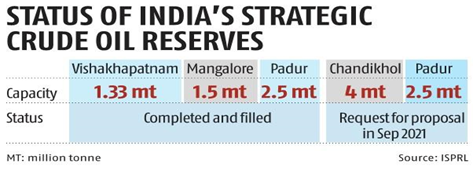

5th June 2023 (8 Topics)
Context
Recently, a Government-owned engineering consultancy firm Engineers India (EIL) is studying the prospects and feasibility of developing salt cavern-based strategic oil reserves in Rajasthan, in line with the government’s objective of increasing the country’s strategic oil storage capacity.
India’s Strategic Oil reserves:
- A strategic reserve is the reserve of a commodity or items that is held back from normal use by governments, in pursuance of a particular strategy or to cope with unexpected events.
- Countries keep strategic reserves of crude oil to meet the immediate demand in times of crisis or unexpected events.
- India, the world’s third-largest consumer of crude, depends on imports for more than 85% of its requirement.
- Government of India through Indian Strategic Petroleum Reserve Ltd. (ISPRL) under Phase–1 has setup Strategic Petroleum Reserves (SPR) at three locations with a capacity of 5.33 MMT (million metric ton) –
- Vishakhapatnam (1.33 MMT),
- Mangaluru (1.50 MMT) and
- Padur (2.5 MMT)

About Salt Cavern-based oil reserves:
- Underground storage caverns are used to store very large quantities of unrefined petroleum and natural gas.
- These underground caverns are cavities that have been “mined” out of naturally occurring salt domes.
- Approximately 7% of total underground natural gas storage capacity is in Salt Caverns.
- Salt caverns are developed by the process of solution mining, which involves pumping water into geological formations with large salt deposits to dissolve the salt.
Salt Cavern-based Storage v/s Rock Cavern-based Storage:
- Rock caverns are large man-made spaces in the rock and are considered the safest means of storing hydrocarbons.
- In comparison to rock caverns, salt caverns are considered cheaper and less labour- and cost-intensive.
- Salt cavern-based oil storage facilities are also naturally well-sealed, and engineered for rapid injection and extraction of oil.
- This makes them a more attractive option than storing oil in other geological formations.
- The entire strategic petroleum reserve programme of the United States has so far been based on salt cavern-based storage facilities.
- In comparison, India’s all 3 strategic petroleum reserves are made up of excavated rock caverns.
India’s Potential:
- Rajasthan, which has the bulk of requisite salt formations in India, is seen as the most conducive for developing salt cavern-based strategic storage facilities.
- A refinery is coming up in Barmer, and Rajasthan has crude pipelines as well; such infrastructure is conducive for building strategic oil reserves.
- However, no Indian company, including EIL, had the requisite technical know-how to build salt cavern-based strategic hydrocarbon storage.
- This gap in access to technology has been bridged by EIL’s recent partnership with Germany’s DEEP.KBB GmbH — a company that specialises in cavern storage and solution mining technology.
More Articles


